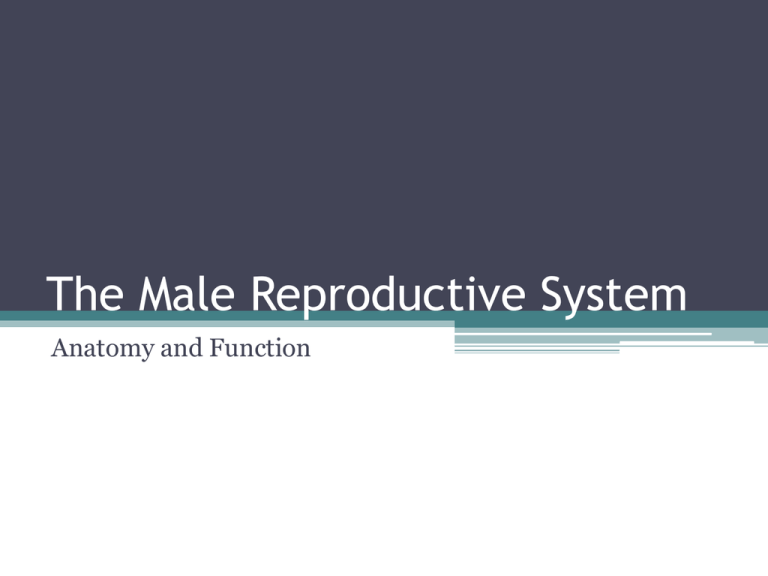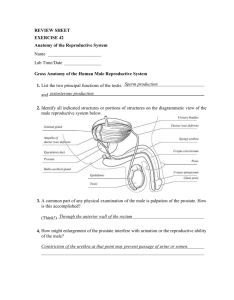
The Male Reproductive System
Anatomy and Function
How many parts can you identify?
What are the functions of these parts?
produces a sticky,
yellowish fluid that
provides sperm cells
energy and aids in
their motility
produce a clear,
slippery fluid that
lubricates and
neutralizes the
urethra
transports the sperm
from the epididymis to
the urethra
produces a milky fluid
which makes up most
of the volume of the
ejaculate
delivers semen to
the female
reproductive tract
conveys both sperm
and urine down the
holds and protects the length of the penis
testes
acts as a maturation
organ that produces
and storage place for
sperm and the male
sperm
hormones
penis
• external organ that
delivers the semen to the
female reproductive tract
• also part of the excretory
system – transports urine
out of body
• composed of erectile
tissue, which becomes
engorged with blood
during an erection
epididymis
• a mass of tightly
coiled tubes cupped
against the testicles
• acts as a maturation
& storage place for
sperm
urethra
• tube that conveys
both sperm & urine
down the length of
the penis
• in the human male,
the urethra is about
8 inches (20 cm)
long (twice as large
as a females)
testis (pl. testes)
• organ that produces sperm
and the male hormones
(primarily testosterone)
• aka: testicle
• males have 2, which are
contained in the scrotum
• The testes work best at
temperatures slightly less
than core body
temperature.
▫ Spermatogenesis is less
efficient at lower and
higher temperatures.
▫ This is presumably why the
testes are located outside
the body.
Review of
Spermatogenesis
scrotum
• a pouch-like structure
that holds and protects
the testes
• allows the testes to
have a slightly lower
temperature than that
of the body
• Why is this necessary?
▫ Spermatogenesis!
seminal vesicle
• sac-like structures attached to the vas deferens at
one side of the bladder
• produces a sticky, yellowish fluid that provides
sperm cells energy and aids in their motility
• results in the majority of the fluid of the ejaculate
• fluid is alkaline
▫ WHY?
To neutralize the acidic environment of the female
vagina!
prostate
• a structure that surrounds
the urethra at the base of the
bladder which produces a
slightly alkaline, milky fluid
• fluid is part of the man’s
ejaculate, or semen
• about the size of the kiwi
fruit and can be felt/checked
during a rectal exam
• also prone to cancer in
middle-aged men
vas deferens
• tubes that transport the
sperm from the
epididymis to the
urethra
• aka: ductus deferens
• often “cut” during a
vasectomy
▫ prevents sperm from
becoming part of the
ejaculate
bulbourethral gland
• pea-sized structure located on the side of the
urethra just below the prostate gland
• aka: Cowper’s gland
• produces a clear, viscous secretion known as the
pre-ejaculate
• this fluid helps to lubricate the urethra for sperm to
pass through, neutralizing traces of acidic urine in
the urethra
• fluid also helps flush out any residual urine or
foreign matter in the urethra












